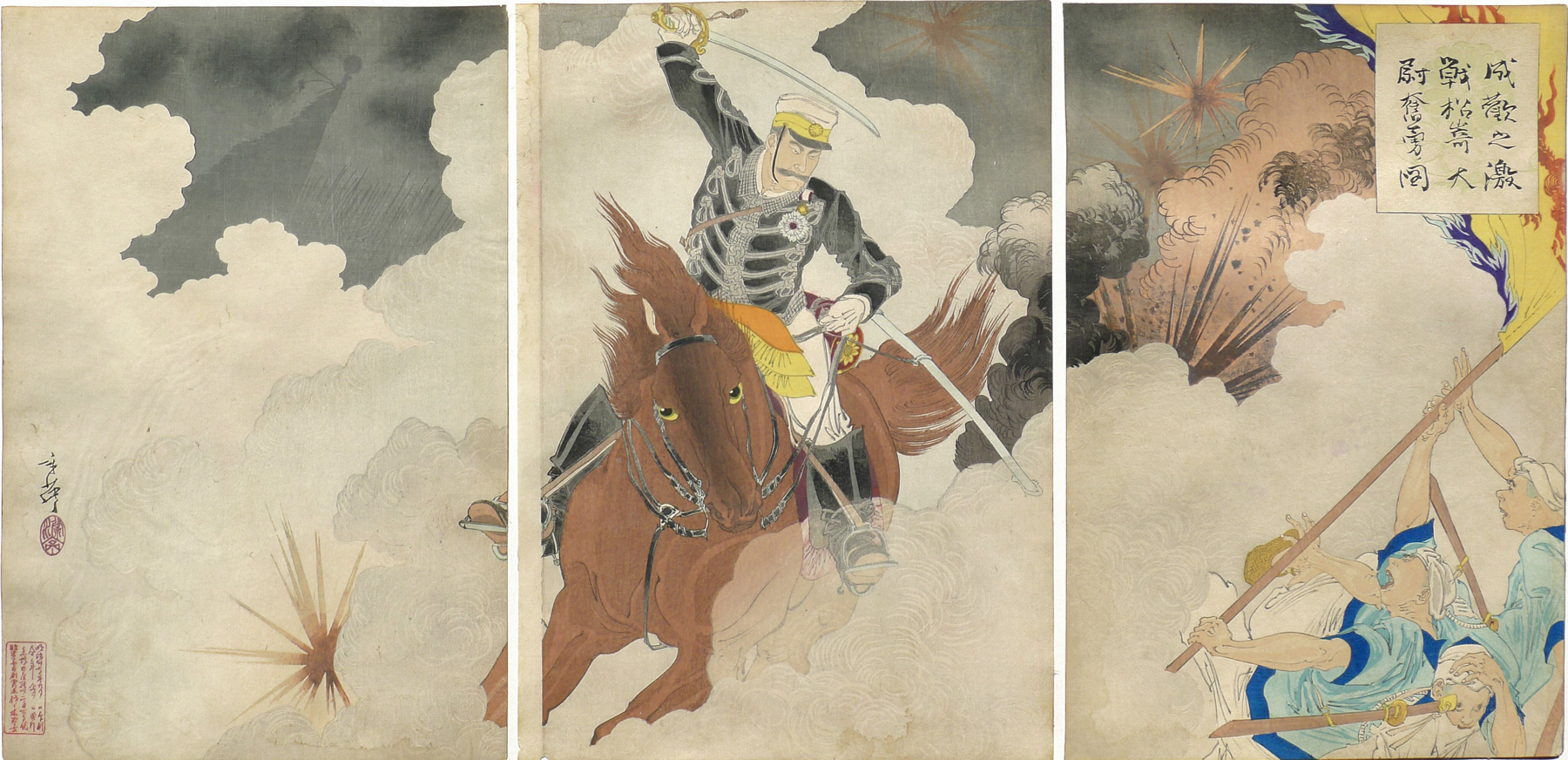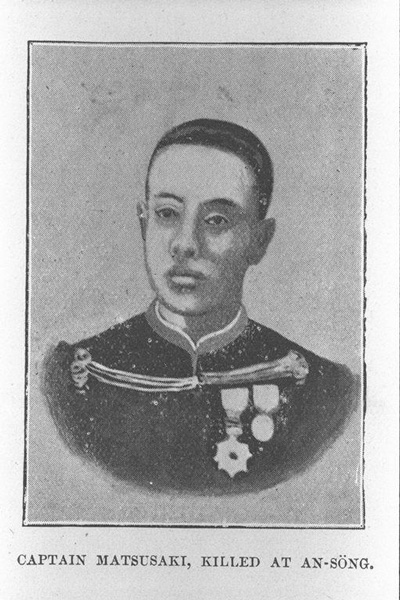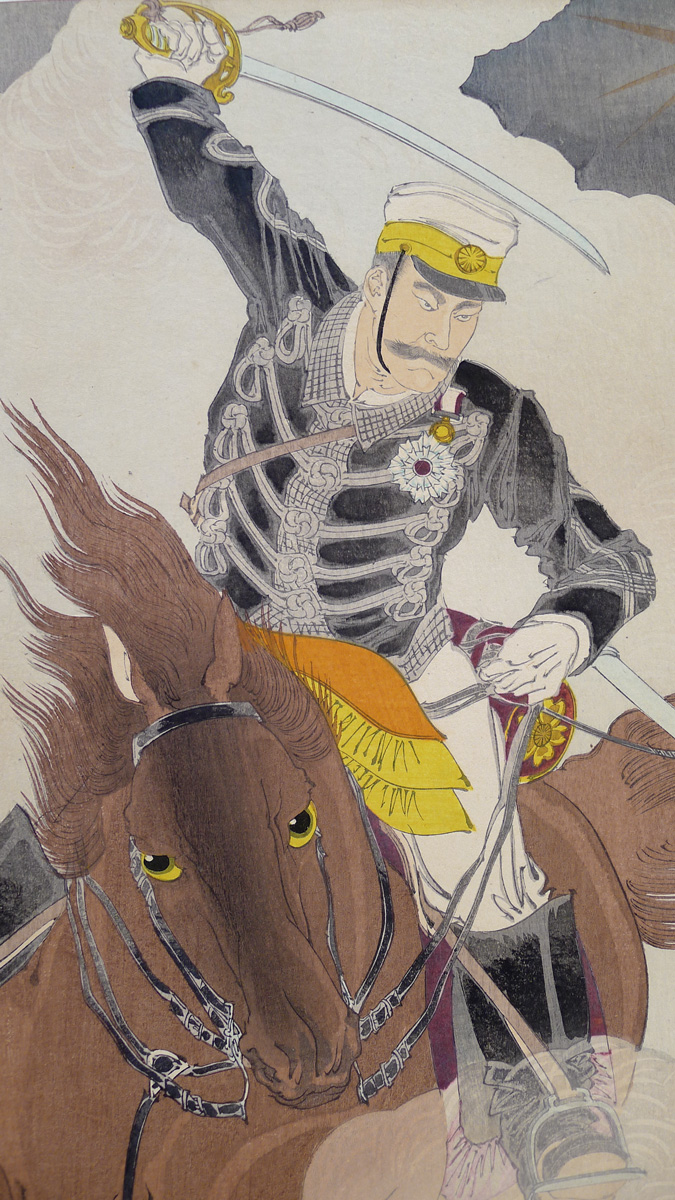About This Print
The Brave Captain Matsuzaki
Source: Impressions of the Front: Woodcuts of the Sino-Japanese War, Shunpei Okamoto, Philadelphia Museum of Art, 1983, p. 20.Before reaching Songhwan, the Japanese troops had to cross the deep Anson river. Forty-year-old Captain Matsuzaki Naoomi from Kumamoto on Kyushu led his men on July 29, 1894, in attacking the enemy on the other side of the river. In this print the fearless captain battles cowering Chinese soldiers. But he was ambushed from one hundred feet and was shot through the leg. Undaunted, he continued to fight gallantly with his sword. When he was struck by another bullet in the head, he is reported to have shouted, “I’ve been hit!” and to have died bravely.
Other prints from this collection featuring the valor of Captain Matsuzaki can be found at The Great Battle of the Ansong Ford: The Valor of Captain Matsuzaki Crossing Anjo and Captain Matsuzaki Crossing the Anjō-sen.
The Real Captain Matsuzaki (Captain Matsusaki, killed at An-song)Overseas Images of Japan Database -International Research Center for Japanese Studies, Kyoto, JapanThe Print's Captain Matsuzaki
Battle of Songhwan
Source: Impressions of the Front: Woodcuts of the Sino-Japanese War, Shunpei Okamoto, Philadelphia Museum of Art, 1983, p. 12.After replacing the pro-Chinese Korean royal government with a royal government more favorable to Japan, the new royal government requested the Japanese to expel Chinese forces in Korea. Provocations against China followed, leading to the first land battle of the Sino-Japanese War (1894-1895) at Songwhan (Seikan in Japanese) on July 29, 1894.1
| Asan, a stronghold south of Seoul, was defended by about thirty-five hundred Chinese troops. The Chinese commander, hearing of the Japanese southern advance, moved some twenty-five hundred troops to Songhwan, a fort northeast of Asan, in order to encounter the Japanese. Before dawn on July 29, the Japanese began fighting, and after two hours of fierce battle, they occupied Songhwan. Immediately reassembling, they pursued the Chinese troops to Asan. Since the Chinese had been stationed at Asan for some time and were bolstered by the added Songhwan troops, stiff resistance from the stronghold was expected. The Japanese advance column arrived in the early evening of July 20 and found that the Chinese had already evacuated; not one Chinese soldier was there. The Japanese occupied Asan without a single loss. |
1 A formal declaration of war between Japan and China would not be officially declared until August 1, 1894.
Print Details
last revision:
Print Details
| IHL Catalog | #690 |
| Title or Description | Captain Matsuzaki Fights Bravely in the Battle of Songhwan 成観之激戦松崎大尉奮勇ノ図 Seikan no gekisen Matsuzaki taii funyū no zu |
| Artist | Migata Toshihide (1863-1925) |
| Signature |  |
| Seal | Gosai 梧斎 |
| Publication Date | September 1894 (Meiji 27) |
| Publisher |  |
| Impression | excellent |
| Colors | excellent |
| Condition | good - backing remnants; separate sheets; soiling throughout, primarily along edges |
| Genre | ukiyo-e; senso-e (Sino-Japanese War) |
| Miscellaneous | |
| Format | vertical oban triptych |
| H x W Paper | 13 1/2 x 9 1/8 in. (34.3 x 23.5 cm) each sheet |
| Literature | Impressions of the Front: Woodcuts of the Sino-Japanese War, Shunpei Okamoto, Philadelphia Museum of Art, 1983, pl.5, p. 20. |
| Collections This Print | Philadelphia Museum of Art; Art Institute Chicago 1995.206.24 |
3/11/2020




